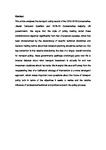The curious death - and life - of British transport policy
| dc.contributor.author | Docherty, I | |
| dc.contributor.author | Shaw, Jon | |
| dc.contributor.author | Marsden, G | |
| dc.contributor.author | Anable, J | |
| dc.date.accessioned | 2018-03-28T13:58:20Z | |
| dc.date.issued | 2018-12 | |
| dc.identifier.issn | 2399-6544 | |
| dc.identifier.issn | 2399-6552 | |
| dc.identifier.uri | http://hdl.handle.net/10026.1/11197 | |
| dc.description.abstract |
<jats:p> This article analyses the transport policy record of the 2010–2015 Conservative–Liberal Democrat Coalition and 2015–2016 Conservative majority UK governments. We argue that the style of policy making under these administrations departed significantly from that of previous decades, which had been characterised by the ascendancy of specific technical disciplines and decision-making norms about how transport planning should be carried out. Our key contention is that despite abandoning the idea of a single, overall narrative for transport policy, these governments (perhaps unwittingly) gave new life to broader debates about what transport investment is actually for and how investment decisions should be made. We interpret this as a shift away from the longstanding idea of a ‘deliberate’ strategy of intervention to a more ‘emergent’ approach, which raises important new questions about the future of transport policy both in terms of the objectives it seeks to realise and the relative influence of professional/technical and political actors in the policy process. </jats:p> | |
| dc.format.extent | 1458-1479 | |
| dc.language | en | |
| dc.language.iso | en | |
| dc.publisher | SAGE Publications | |
| dc.subject | Deliberate strategy | |
| dc.subject | emergent strategy | |
| dc.subject | policy appraisal | |
| dc.subject | transport | |
| dc.title | The curious death - and life - of British transport policy | |
| dc.type | journal-article | |
| dc.type | Journal Article | |
| plymouth.author-url | https://www.webofscience.com/api/gateway?GWVersion=2&SrcApp=PARTNER_APP&SrcAuth=LinksAMR&KeyUT=WOS:000453100100007&DestLinkType=FullRecord&DestApp=ALL_WOS&UsrCustomerID=11bb513d99f797142bcfeffcc58ea008 | |
| plymouth.issue | 8 | |
| plymouth.volume | 36 | |
| plymouth.publication-status | Published | |
| plymouth.journal | Environment and Planning C: Politics and Space | |
| dc.identifier.doi | 10.1177/2399654418764451 | |
| plymouth.organisational-group | /Plymouth | |
| plymouth.organisational-group | /Plymouth/Faculty of Science and Engineering | |
| plymouth.organisational-group | /Plymouth/Faculty of Science and Engineering/School of Geography, Earth and Environmental Sciences | |
| plymouth.organisational-group | /Plymouth/REF 2021 Researchers by UoA | |
| plymouth.organisational-group | /Plymouth/REF 2021 Researchers by UoA/UoA14 Geography and Environmental Studies | |
| plymouth.organisational-group | /Plymouth/Users by role | |
| plymouth.organisational-group | /Plymouth/Users by role/Academics | |
| dcterms.dateAccepted | 2018-03-26 | |
| dc.identifier.eissn | 2399-6552 | |
| dc.rights.embargoperiod | Not known | |
| rioxxterms.funder | Engineering and Physical Sciences Research Council | |
| rioxxterms.identifier.project | UK Energy Research Centre Phase 3 | |
| rioxxterms.versionofrecord | 10.1177/2399654418764451 | |
| rioxxterms.licenseref.uri | http://www.rioxx.net/licenses/all-rights-reserved | |
| rioxxterms.licenseref.startdate | 2018-12 | |
| rioxxterms.type | Journal Article/Review | |
| plymouth.funder | UK Energy Research Centre Phase 3::Engineering and Physical Sciences Research Council |


